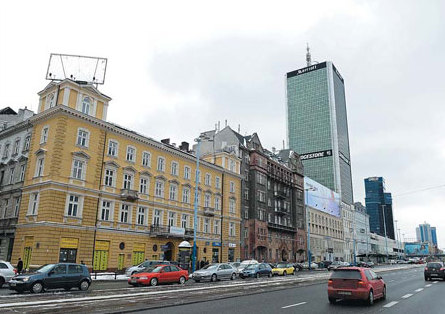Pre-war Warsaw rises in 3D
|
A street in downtown Warsaw. Nearly 70 years after World War II, the pre-war Polish capital has been brought back to life thanks to a new film, using cutting-edge three-dimensional computer imaging. Janek Skarzynski / Agence France-Presse |

Nazi bombs left Warsaw as little more than a heap of rubble at the end of World War II.
Now, nearly 70 years later, the charm of the pre-war Polish capital, dubbed the "Paris of the north", has been brought back to life for the first time thanks to a new film, using three-dimensional computer imaging.
Whether from the eye of an eagle soaring over the skyline, a pigeon flying down city streets, or passengers on a tram, Warszawa 1935 invites viewers into the lush squares and parks of the city center, a vanished world that very few still recall.
For Stefan Zoltowski, now 84, seeing Warszawa 1935 rekindled memories he thought were long lost.
"It's impressive. I saw part of the street on which I spent my childhood," said the retired physician who grew up in the heart of Warsaw.
The Nazis razed the apartment building belonging to his family to the ground during the 1944 Warsaw Uprising.
More than 80 percent of Warsaw was destroyed by the Nazis, and more than 700,000 of its 1.3 million pre-war residents perished under German occupation from 1939 to 1945.
New landscape
Today, a shopping mall and the landmark Palace of Culture built by the Soviet Union just after the war stand on the streets where Zoltowski once played with childhood friends.
The 237-meter-high Palace of Culture is now flanked by parking lots, parks and skyscrapers, which have transformed the city center almost beyond recognition over the past two decades.
The new 3D film, which shows the city as it was before its destruction and subsequent revamps, fills a deep yearning for "the Warsaw we miss," said Ryszard Maczewski, head of the Warszawa1939.pl foundation working to document the capital's pre-war design.
Film producer, Ernest Rogalski, said at the film premiere: "No one has done this before. It's been quite a challenge."
The production team scoured the Internet and the national archives in search of photos and city plans that could serve as the basis for its virtual reconstruction.
As luck would have it, the national archives held detailed late 19th century plans made by celebrated British civil engineer William Lindley for the city's waterworks, which proved to be a treasure trove of information. His waterworks are still in use today.
"It's a map-making masterpiece," said Pawel Weszpinski, a cartographer with Poland's National Archives.
Only three European cities of the era - Warsaw, Frankfurt and Hamburg - were mapped at a scale of 1:200 with such intricate precision. Even trees in Warsaw were drawn to scale.
12 terabytes of data
Meanwhile, pre-war commercial registries gave clues about the location of shops and other businesses, allowing the moviemakers to put up advertising logos and company signs in just the right spots.
But getting all this information on the silver screen took a whopping 12 terabytes of digital imaging in what can only be described as a programming project of mammoth proportions.
"It took enormous computing capacity to render our three-dimensional images. We used servers at the Polish Institute for Nuclear Research and at a data center in China. In Europe, nobody wanted to help us, for fear of overloading their servers," said film director Tomasz Gomol.
Their digital city tour is quick, just 20 minutes, and does not allow the viewer to linger and admire its richness of detail.
"That inconvenience will change soon when the film comes out on DVD and Blu-ray," said Gomol as he revealed plans are afoot for a sequel digital journey into Warsaw's forgotten past.
Agence France-Presse
(China Daily 04/02/2013 page10)















